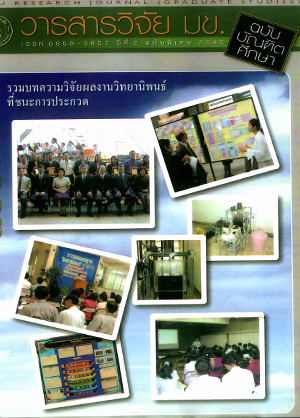The Development of A Self-directed Learning System for Public Health Students(การพัฒนาระบบการเรียนด้วยตนเองสำหรับนักศึกษาสาขาวิชาชีพสาธารณสุข)
Keywords:
Self-directed learning, Public health studentsAbstract
The aims of this study were to develop a self-directed learning system for Public Health students and to examine the effects of the system on improvement of expected self-directed learning competence, learning achievement, and attitudes towards self-directed learning. The researcher conducted systems analysis by studying the context and concept of the self-directed learning system, and proposed a new self-directed learning system through the process of systems synthesis, and systems appraisal. The proposed self-directed learning system was verified by seven experts and an action research before replication in three selected courses in Public Health. The population was a group of Public Health instructors and students enrolled in Public Health colleges under the Praboromarajchanok Institute for Health Manpower Development, the Ministry of Public Health. Different sample groups were used. For the contextual study, the sample group consisted of 12 instructors and 150 students in the Certificate in Public Health (Community Health); for the action research, the sample group comprised 44 students in the Certificate in Public Health (community Health) and 17 students in the Certificate in Public Health (Ambulance Officer); for the replication and evaluation of the systems efficiency, the sample group consisted of 45 first-year Certificate in Public Health (Community Health) students, 16 first-year Certificate in Public Health (Emergency Medical Technician) students, and 16 second-year Certificate in Public Health (Ambulance Officer) students. The study tools employed at different stages were as follows: at the contextual study stage, a questionnaire to survey current status and needs for self-directed learning was used; at the action research stage, instructional records, the instructors and students behavior observation records, student semi-structured interviews, instructional evaluation forms, learning contracts, learning logs, performance tests, self-evaluation of cooperative learning forms, cooperative learning observation forms, exercises, quizzes, students portfolios assessment forms, learning achievement tests, self-directed learning competence, and attitudes towards self-directed learning questionnaires were used. At the systems efficiency evaluation stage, a set of tools for measuring self-directed learning levels, and an open-ended questionnaire concerning the replication of the self-directed learning system were used. The data, then, were analyzed by means of percentage, mean, standard deviation, a t-test and typology analysis. An evaluation of the efficiency of the systems is assessed in terms of an improvement of the mean score of three important aspects: self-directed learning competence, learning achievement and attitudes towards self-directed learning. The findings of the study revealed that the six components used and procedures undertaken to develop a self-directed learning system comprised analysis of learning objectives, preparation of instructors and students, preparation of learning environment, preparation for self-directed learning process, implementation of self-directed learning procedures, and conduction of evaluation. In assessing the improvement of self-directed learning competence, the post-mean score was found to be higher than the former at the significant level of 0.05. The assessment of learning achievement by comparing the mean score with the Public Health standard score showed that the latter was found to be higher than the former at the significant level of 0.05. Last but not least, the assessment of students attitudes towards self-directed learning by comparing the mean score with a standard attitudes score reflected that they were not different at the significant level of 0.05.
การวิจัยครั้งนี้มีวัตถุประสงค์เพื่อพัฒนาระบบการเรียนด้วยตนเองสำหรับ นักศึกษาสาขาวิชาชีพสาธารณสุข และศึกษาผลของการใช้ระบบการเรียนด้วยตนเองต่อคุณลักษณะ ในการเรียนด้วยตนเอง ผลสัมฤทธิ์ทางการเรียน และเจตคติต่อการเรียนด้วยตนเองของ นักศึกษา ดำเนินการวิจัยโดยการศึกษาบริบท การศึกษากรอบแนวคิด การสังเคราะห์ระบบ การตรวจสอบระบบโดยผู้ทรงคุณวุฒิ การพัฒนาประสิทธิภาพของระบบโดยการวิจัยปฏิบัติการ การขยายผลระบบโดยนำไปใช้กับรายวิชาในสาขาวิชาชีพสาธารณสุขและการประเมินระบบตามเกณฑ์ ที่กำหนดขึ้น ประชากรที่ศึกษาเป็นนักศึกษาและคณาจารย์หลักสูตรประกาศนียบัตรสาธารณสุขศาสตร์ ใน วิทยาลัยการสาธารณสุขสิรินธร สังกัดสถาบันพระบรมราชนก สำนักงานปลัดกระทรวงสาธารณสุข กระทรวงสาธารณสุข กลุ่มตัวอย่างที่ใช้ในการวิจัยได้แก่ (1) กลุ่มตัวอย่างที่ใช้ใน การศึกษาบริบทเป็นคณาจารย์และนักศึกษาหลักสูตรประกาศนียบัตรสาธารณสุขศาสตร์ (สาธารณสุขชุมชน) ชั้นปีที่ 1 ปีการศึกษา 2542 ในวิทยาลัยการสาธารณสุขสิรินธรที่สุ่มได้ จำนวน 12 คน และ 150 คน ตามลำดับ (2) กลุ่มตัวอย่างที่ใช้ในการวิจัยปฏิบัติการ เป็นนักศึกษาหลักสูตรประกาศนียบัตรสาธารณสุขศาสตร์ (สาธารณสุขชุมชน) และหลักสูตร ประกาศนียบัตรสาธารณสุขศาสตร์ (กู้ชีพ) ชั้นปีที่ 1 ที่เรียนรายวิชา ชส. 102 การดูแล สุขภาพครอบครัวแบบองค์รวม ปีการศึกษา 2543 วิทยาลัยการสาธารณสุขสิรินธร จังหวัดขอนแก่น จำนวน 61 คน และ (3) กลุ่มตัวอย่างที่ใช้ในการขยายผลและประเมินระบบเป็นนักศึกษา ในปีการศึกษา 2544 วิทยาลัยการสาธารณสุขสิรินธร จังหวัดขอนแก่น หลักสูตรประกาศนียบัตร สาธารณสุขศาสตร์ (สาธารณสุขชุมชน) ชั้นปีที่ 1 ที่เรียนรายวิชา ชส.102 การดูแลสุขภาพ ครอบครัวแบบองค์รวม จำนวน 45 คน นักศึกษาหลักสูตรประกาศนียบัตรสาธารณสุขศาสตร์ (เวชกิจฉุกเฉิน) ชั้นปีที่ 1 ที่เรียนรายวิชา ชว.105 ระบบบริการการแพทย์ฉุกเฉิน จำนวน 16 คน และนักศึกษาหลักสูตรประกาศนียบัตรสาธารณสุขศาสตร์ (กู้ชีพ) ชั้นปีที่ 2 ที่เรียนรายวิชา ชก.2208 การบริการการแพทย์ฉุกเฉินนอกโรงพยาบาล จำนวน 16 คน เครื่องมือที่ใช้ในการวิจัยประกอบด้วย (1) เครื่องมือที่ใช้ในการศึกษาบริบท ได้แก่ แบบสำรวจสภาพปัจจุบันและความต้องการการจัดการเรียนการสอนที่ส่งเสริมการเรียน ด้วยตนเอง (2) เครื่องมือที่ใช้ในการวิจัยปฏิบัติการ ได้แก่ แบบบันทึกการจัดการเรียน การสอน แบบบันทึกการสังเกตพฤติกรรมผู้เรียนและผู้สอนแบบสัมภาษณ์ผู้เรียนชนิดกึ่ง โครงสร้าง แบบประเมินการจัดการเรียนการสอน แบบสัญญาการเรียน แบบบันทึกการเรียน แบบประเมินทักษะปฏิบัติ แบบประเมินตนเองเกี่ยวกับพฤติกรรมการเรียนแบบร่วมมือ แบบ สังเกตเกี่ยวกับพฤติกรรมการเรียนแบบร่วมมือ แบบประเมินชิ้นงาน แบบฝึกหัด แบบทดสอบย่อย แบบวัดคุณลักษณะในการเรียนด้วยตนเอง แบบวัดผลสัมฤทธิ์ทางการเรียน และแบบวัดเจตคติ ต่อการเรียนด้วยตนเอง แบบวัดผลสัมฤทธิ์ทางการเรียน แบบวัดเจตคติต่อการเรียนด้วยตนเอง แบบวัดระดับการเรียนด้วยตนเอง และแบบสอบถามปลายเปิดเกี่ยวกับการจัดการเรียนการสอน โดยใช้ระบบการเรียนด้วยตนเอง วิเคราะห์ข้อมูลโดยหาค่าร้อยละ ค่าเฉลี่ย ส่วนเบี่ยงเบน มาตรฐาน ทดสอบ t และวิเคราะห์จำแนกประเภท ทั้งนี้การประเมินประสิทธิภาพของระบบ ใช้การเปรียบเทียบคะแนนเฉลี่ยคุณลักษณะในการเรียนด้วยตนเอง ผลสัมฤทธิ์ทางการเรียน และเจตคติต่อการเรียนด้วยตนเองกับเกณฑ์ที่กำหนดขึ้น ผลการวิจัยพบว่าระบบการเรียนด้วยตนเองสำหรับนักศึกษาสาขาวิชาชีพสาธารณสุข ที่ผู้วิจัยพัฒนาขึ้นประกอบด้วยองค์ประกอบและขั้นตอน 6 ประการ คือ การวิเคราะห์ จุดประสงค์การเรียน การเตรียมผู้เรียนและผู้สอน การเตรียมสภาพแวดล้อมในการเรียน การเตรียมการเรียนด้วยตนเอง การดำเนินการเรียนการสอน และการประเมินการเรียนการสอน ส่วนผลการประเมินระบบการเรียนด้วยตนเองสำหรับนักศึกษาสาขาวิชาชีพสาธารณสุขพบว่า ระบบการเรียนด้วยตนเองที่ผู้วิจัยพัฒนาขึ้นเป็นระบบที่มีประสิทธิภาพ โดยสามารถส่งผล ให้ผู้เรียนมีคุณลักษณะตามเกณฑ์ประสิทธิภาพของการประเมินระบบที่กำหนดขึ้นคือคะแนน เฉลี่ยคุณลักษณะในการเรียนด้วยตนเองก่อนเรียนอย่างมีนัยสำคัญทางสถิติที่ระดับ 0.05 คะแนนเฉลี่ยผลสัมฤทธิ์ทางการเรียนสูงกว่าคะแนนเกณฑ์มาตรฐานวิชาชีพสาธารณสุขอย่าง มีนัยสำคัญทางสถิติที่ระดับ 0.05 และคะแนนเฉลี่ยเจตคติต่อการเรียนด้วยตนเองของผู้ เรียนไม่แตกต่างกัยบคะแนนเกณฑ์เจตคติที่กำหนดขึ้นอย่างมีนัยสำคัญทางสถิติที่ระดับ 0.05



